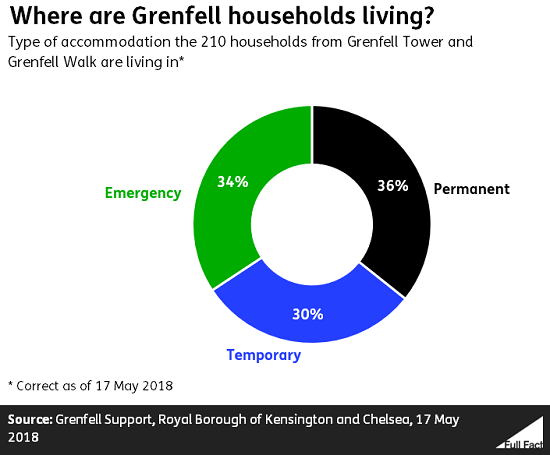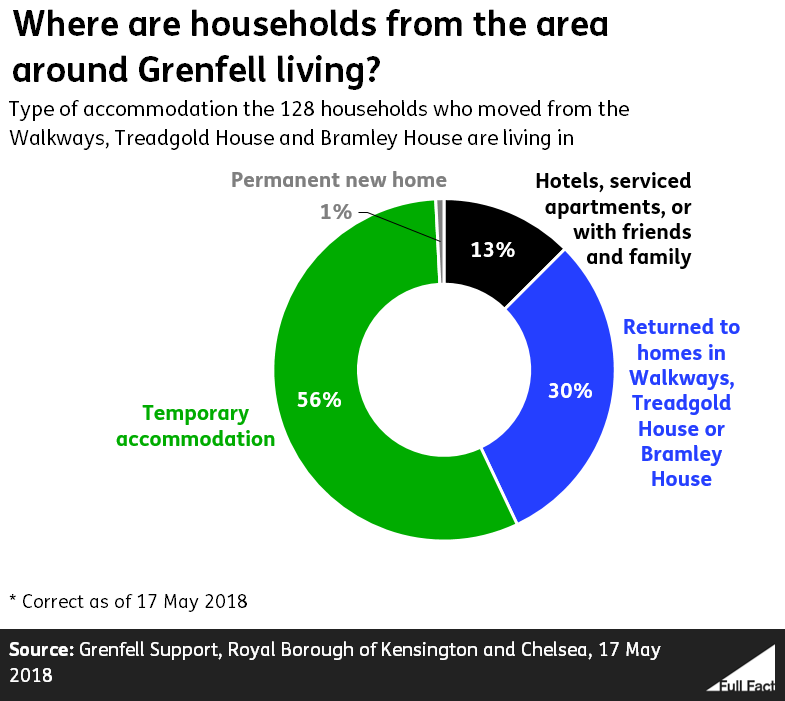This piece no longer contains the latest figures. You can read our article with the latest figures on where households from Grenfell Tower and the surrounding area are living here.
“Most of the people made homeless by the Grenfell Tower fire are not in permanent accommodation.”
Diane Abbott, 17 May 2018
“We have 201 of the 210 households who have accepted or moved into temporary or permanent accommodation.”
Dominic Raab, 17 May 2018
Most households that lived in Grenfell Tower or in neighbouring Grenfell Walk made homeless by the fire have not yet moved into permanent accommodation. It’s also correct that most have accepted or moved into temporary or permanent housing.
According to Grenfell Support, a Kensington and Chelsea council-led initiative, 75 of the 210 households from Grenfell Tower and Grenfell Walk have now moved into permanent homes. This is just over one third.
They say 63 households have moved into temporary accommodation, while 72 are still in emergency accommodation. These figures are accurate as of 17 May.

The Royal Borough of Kensington and Chelsea told us the most up to date figure as of 17 May was that 202 households had now accepted or moved into temporary or permanent homes. This 202 figure can’t be reached from Grenfell Support’s published figures, which do not break down what kind of accommodation the people who have accepted offers are currently living in.
The Ministry of Housing, Communities and Local Government said that Dominic Raab gets bi-weekly updates on the figure, and when BBC Question Time was recorded he had most recently been briefed with Monday’s figure of 201.
During a Commons debate on 16 May on the Grenfell Tower tragedy, Secretary of State for Housing, Communities and Local Government James Brokenshire said there were “people who have accepted an offer of a permanent home still living in emergency accommodation”.
Grenfell Support also say that “households currently living in temporary accommodation provided by the Council or our partners, also have the option to make these properties their permanent home if they wish.”
Honesty in public debate matters
You can help us take action – and get our regular free email
Rehousing in the wider Grenfell area
After the fire, 128 households moved out of their homes in the area surrounding Grenfell Tower.
Of the 128 households who left the surrounding flats, as of 17 May, one had accepted and moved into a permanent home. 39 households had returned to their homes, 16 households were in hotels, serviced apartments or were staying with friends and family and 72 households had moved into temporary accommodation.

The council has published more information on who is eligible for their wider Grenfell rehousing policy here.
Grenfell Support updates their rehousing figures for Grenfell Tower and Walk residents and wider Grenfell area tenants once a week. Since this article was originally written new figures have been released.
As of 24 May, 80 households from Grenfell Tower and Grenfell Walk are now in permanent accommodation, 58 are in temporary accommodation and 72 are in emergency accommodation. The council told us 203 households had moved into or accepted offers for permanent or temporary homes.
For households in the wider Grenfell area, the figures are largely the same, although one less household is in a hotel, serviced apartment or with friends and family, and one more is in temporary housing.

